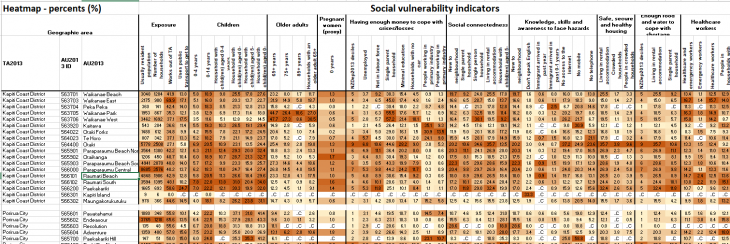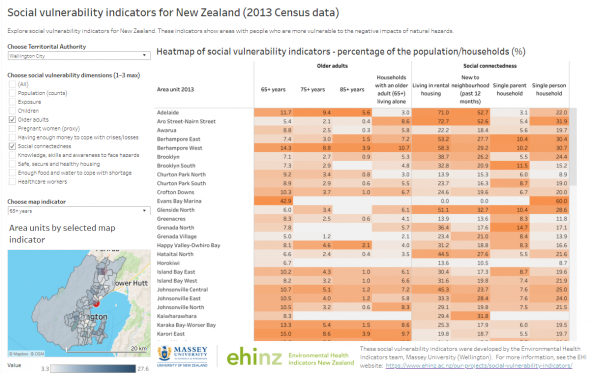Social vulnerability indicators for 2013
This section provides an overview of the social vulnerability indicators for flooding, for 2013. These indicators were developed as part of a funded research project.
For the latest version of the indicators, see the Social vulnerability indicators for 2023 webpage.
On this page:
About the research project
In 2017-19, we carried out a research project to develop a set of social vulnerability indicators for flooding for New Zealand.
We used a case study of Porirua, Wellington, New Zealand, to test the indicators. The project included working with stakeholders, including Porirua City Council, local health services, Wellington Region Emergency Management Office (WREMO) and Ngāti Toa Rangatira. The final set of social vulnerability indicators were based on 2013 Census data.
This research project was funded by the Natural Hazards Research Platform.
The indicators
Social vulnerability indicators are used to identify populations and geographic areas that are more vulnerable to the negative impacts of floods. In these areas, people may be less able to anticipate, prepare for, cope with, and recover from a flood.
The social vulnerability indicators cover the following topics:
- Exposure: direct exposure; indirect exposure
- Susceptibility: children; older adults; people with physical health needs; people with mental health needs; people with a disability
- Resilience: enough money to cope with crises/losses; social connectedness; knowledge, skills and awareness to face hazards; safe, secure and healthy housing; enough food and water to cope with shortage; decision-making and leadership.
The final indicator set included data from the 2013 Census, for small areas (census area units) across New Zealand. Point locations were also identified that relate to vulnerable populations (such as schools, aged care facilities, and health care facilities).
For more information about the development of the 2013 social vulnerability indicators, see the Reports and publications webpage.
Porirua case study
This project included a case study for Porirua. To explore the interactive online map of indicators, visit the Social Vulnerability Indicators Story Map for Porirua website.
Indicator data for New Zealand
Indicator data is available to download for a range of geographies, including territorial authority, area unit, and meshblock (where possible). Indicator data is mainly from the 2013 Census.
Social vulnerability indicators - heatmap and territorial authority summary (Oct 2019) (xlsx, 6.8MB): This dataset provides summary indicator data by area unit and territorial authority, for the whole of New Zealand. Indicator data are presented as summary 'heatmaps', to show indicators at a glance.
Figure 1: Example of social vulnerability indicators 'heatmap' from the Excel file
Social vulnerability indicators - full indicator dataset (Oct 2019) (xlsx, 37MB): This dataset provides the full set of indicators, by territorial authority, area unit, and meshblock (where possible). Data about population demographics, languages spoken, and population projections have also been included. The indicator data is mainly from the 2013 Census.
Data Explorer tool for the social vulnerability indicators
This Data Explorer presents the 2013 Social Vulnerability Indicators, with an interactive heatmap by territorial authority. Indicators are presented at the area unit level.
Visit the Data Explorer for the Social Vulnerability Indicators 2013
Full list of the 2013 social vulnerability indicators
The list below provides the social vulnerability indicators for 2013.
|
Exposure |
People who regularly commute outside of the area People who use public transport to get to and from work People living in rural or remote communities |
|
Children |
Children aged 0–4 years Children aged 0–14 years Households with at least one child |
|
Older adults |
Older adults aged 65+ years Older adults aged 75+ years Older adults aged 85+ years Households with an older adult (65+ years) living alone |
|
Physical health needs |
Pregnant women |
|
Mental health needs |
People with a psychological or psychiatric impairment |
|
Disability |
People with a disability (physical, hearing, vision, psychological or psychiatric impairment) |
|
Having enough money to cope with crises/losses |
Socioeconomic deprivation (NZDep2013) Single-parent households Unemployed people People who are not in the labour force People with minimal education Households with no access to a car People working in the primary industries |
|
Social connectedness |
People who are new to the neighbourhood Households with an older adult (65+ years) living alone Single-parent households Single-person households Households living in rental housing Neighbourhoods with fewer households with children Recent immigrants |
|
Knowledge, skills and awareness of natural hazards |
People who are new to the neighbourhood Households with no access to the internet / mobile phone / telephone People with limited English proficiency Recent immigrants |
|
Safe, secure and healthy housing |
Households living in rental housing Crowded households People living in crowded households People who are homeless and/or severely housing deprived |
|
Enough food and water (and other essentials) to survive (proxy indicators) |
Households living in rental housing Single-parent households Socioeconomic deprivation (NZDep2013) |
|
Decision-making and leadership |
Level of voting participation in the community |
|
Other individual-level factors of social vulnerability |
Healthcare workers and emergency services workers (ambulance, police, fire) Households with one or more healthcare workers and/or first responders Registered dog owners (and number of dogs) |
Project team and acknowledgements
We are grateful to the Natural Hazards Research Platform for funding this two-year project.
This project was led by the Environmental Health Intelligence New Zealand (EHINZ) team from Massey University: Kylie Mason, Kirstin Lindberg, Carolin Haenfling, Allan Schori, Helene Marsters, Barry Borman, Deborah Read.
The project team also included Rawiri Faulkner (Tūtaiao Ltd), Ben Popovich (NIWA), Kristie-Lee Thomas (GNS Science), James Beban and Sarah Gunnell (Urban Edge Planning Ltd).
We would like to thank our stakeholders for their time and help with this project, including Ngāti Toa Rangatira, Porirua City Council, Wellington Region Emergency Management Office (WREMO), Regional Public Health, Capital and Coast DHB, Tū Ora Compass Health PHO, Ministry of Civil Defence and Emergency Management, GNS Science and NIWA.


